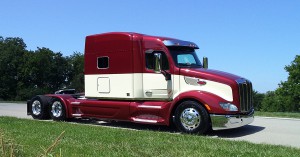 This month’s cool creation was built for Ryan Hooten of Ryan’s Feed and Trucking in Weatherford, Texas. Some of you may recognize Ryan because one of his hay-hauling trucks was featured on our cover back in February of 2008. Back then, Ryan had just the one truck, he lived in California, and he and his wife Deedee had no kids (she was pregnant at the time). Well, a lot has changed in Ryan’s life since then!
This month’s cool creation was built for Ryan Hooten of Ryan’s Feed and Trucking in Weatherford, Texas. Some of you may recognize Ryan because one of his hay-hauling trucks was featured on our cover back in February of 2008. Back then, Ryan had just the one truck, he lived in California, and he and his wife Deedee had no kids (she was pregnant at the time). Well, a lot has changed in Ryan’s life since then!
Over the past few years, Ryan (41) has been adding trucks to his hay-hauling operation. Today, he has six trucks – a 1995 2-axle Pete 379 (the old cover truck); a 2006 3-axle Pete 379; a 2007 3-axle Pete 379; a 2009 3-axle Pete 389; and a 2010 2-axle Pete 388 with a Jiff-Lock (a removable 3rd axle for versatility); and, of course, the new model 579 seen here. Since leaving California and moving to Texas about a year ago, Ryan has expanded his hay-hauling business to include anything he can put on his flatbeds – and one of his trucks is even dedicated 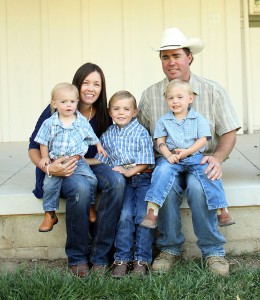 to pulling a reefer trailer.
to pulling a reefer trailer.
Growing up on a ranch and being a huge fan of horses and rodeo, Ryan and his family feel right at home in Weatherford, Texas – which just happens to be the cutting horse capital of the world. These days, Ryan and Deedee now have three boys – R.J. (6), Cash (4), and Cooper (2). When Deedee isn’t chasing after one (or two, or three) of the kids, she handles all of the billing and paperwork, dispatching, brokering, licensing, and anything else that needs to be done to run their family operation. In addition to all that, she also manages the books for a trucking company in California, too. Ryan gets out and drives every week, and makes sure to take at least one trip to the west coast each month.
For years now, Ryan has bought, sold and hauled hay to many horse owners, but he recently came to the realization that the game has changed and it might be time to adapt. Back in the day, running around California, he could haul two loads of hay a day. Now, with droughts and killer beetles, Ryan’s hauls are longer – today, it might take two days to deliver one load of hay, as he now runs all over the 11 western states. For that reason, fuel mileage has become a much bigger issue. With all this in mind, Ryan decided to order a new model 579 Peterbilt. But Ryan has a certain standard that he wouldn’t drop below, so he decided if he was going to order an “aero” truck, it was going to be something special – a limited edition 75th anniversary 579, loaded up with all the goodies. He also wanted Clint to “work his magic” and make it look a little cooler (which is hard to do without removing all of the fuel-saving items on the truck).
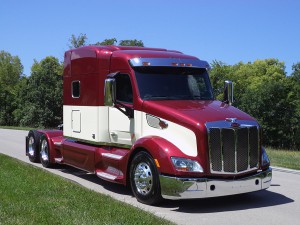 These anniversary edition rigs come with a lot of unique options, making them destined to be collector items. Some of the unique exterior features include a larger oval-punched grille, bright air intake bezels and rocker panels on each side, a 75th Anniversary emblem on each side of the sleeper, and special 75th Anniversary mudflaps. Inside the truck you will find a dark top dash and door panels with Blackwood accents, dark carpet, a numbered 75th Anniversary emblem on the dash (all of these special edition trucks are numbered – Ryan’s is #83), a custom stitched steering wheel, Peterbilt Evolution LX seats in black leather with the 75th Anniversary emblem stitched into the headrests, a Blackwood shifter knob, a custom chrome shifter plate, and Blackwood cabinet trim in the sleeper.
These anniversary edition rigs come with a lot of unique options, making them destined to be collector items. Some of the unique exterior features include a larger oval-punched grille, bright air intake bezels and rocker panels on each side, a 75th Anniversary emblem on each side of the sleeper, and special 75th Anniversary mudflaps. Inside the truck you will find a dark top dash and door panels with Blackwood accents, dark carpet, a numbered 75th Anniversary emblem on the dash (all of these special edition trucks are numbered – Ryan’s is #83), a custom stitched steering wheel, Peterbilt Evolution LX seats in black leather with the 75th Anniversary emblem stitched into the headrests, a Blackwood shifter knob, a custom chrome shifter plate, and Blackwood cabinet trim in the sleeper.
Since most of Ryan’s trucks are white and maroon (or something similar), he wanted this new one to use a similar color scheme to keep the flow, so they ordered it in a metallic burgundy color and cream. The truck also came with an 80-inch sleeper with windows on the sides, a 250-inch wheelbase on Low-Air with an air-ride front axle, a PACCAR MX 500 horsepower engine, an 18-speed transmission with a chrome shifter, and 3:08 rear gears. The truck was also ordered with an aluminum 5th wheel with a longer slide for more versatility, low-pro 22.5 tires on Pete “slot-style” wheels, all of the factory fairings (except for the top air bubble), chrome mirrors and bumper, an Espar heater for 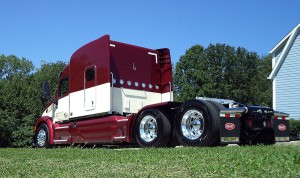 the sleeper on those chilly Texas nights, and a factory-mounted power inverter with shore power.
the sleeper on those chilly Texas nights, and a factory-mounted power inverter with shore power.
When the truck arrived, Clint and his crew went to work – but they didn’t have to do too much. The truck was sprayed with the limited edition paint scheme at the factory, but they don’t paint the back of the sleeper, so Clint and his guys did. They also painted the air intake screens and door handles, and since Ryan didn’t want the “boat style” antennas on the cab, the guys in the shop ran all new coax to the back of the sleeper and installed a CB bracket near the roof. They also added eight flush-mounted LED load lights to the back of the sleeper, and then Moose installed a dump valve on the steer axle. The guys in the shop also installed a set of Fisher fenders, trimmed to match the side skirts, on a set of Clint’s brackets. Then, Clint trimmed the factory rubber flap supports to give it a sleeker look. Lastly, the air and electrical connections were ran to the back of the frame.
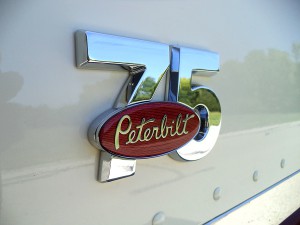 In the short time Ryan has owned this truck, it has proven itself to be very efficient. Ryan’s driver, Jeff Miller, has reported some amazing results – this rig is getting anywhere from 7.5 to 9 mpg, and the fuel savings alone is enough to make the truck payment. Peterbilt has always been on the cutting edge of technology, and these incredible efficiency gains really help illustrate that fact. Let’s take a quick look back at the history and some of the milestones Peterbilt has achieved over the past 75 years.
In the short time Ryan has owned this truck, it has proven itself to be very efficient. Ryan’s driver, Jeff Miller, has reported some amazing results – this rig is getting anywhere from 7.5 to 9 mpg, and the fuel savings alone is enough to make the truck payment. Peterbilt has always been on the cutting edge of technology, and these incredible efficiency gains really help illustrate that fact. Let’s take a quick look back at the history and some of the milestones Peterbilt has achieved over the past 75 years.
Peterbilt was formed in 1939 when Al Peterman, a successful businessman who owned a wooden-door manufacturing company, began looking for a way to create a more reliable and steady supply of timber for his operation. Buying the failing Fageol Motors Company and their dying factory in Oakland, California, Peterman set out to build his own trucks that would provide him with the level of performance his business demanded. He named his company Peterbilt. By the end of the first year, 16 of what would become hundreds of thousands of trucks to proudly bear the Peterbilt badge, were built.
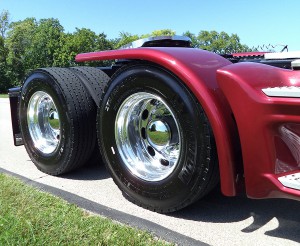 In 1950, the model 350 was introduced, which was a popular truck in its day. A few years later, in 1953, the red Peterbilt oval, one of the most recognizable brand logos in the world, was created. The following year, in 1954, the model 351 was introduced, and it enjoyed the longest production run in the company’s history. In 1958, Peterbilt was acquired by the Pacific Car & Foundry Company (which later became PACCAR), and then moved to a new manufacturing facility in Newark, California in 1960.
In 1950, the model 350 was introduced, which was a popular truck in its day. A few years later, in 1953, the red Peterbilt oval, one of the most recognizable brand logos in the world, was created. The following year, in 1954, the model 351 was introduced, and it enjoyed the longest production run in the company’s history. In 1958, Peterbilt was acquired by the Pacific Car & Foundry Company (which later became PACCAR), and then moved to a new manufacturing facility in Newark, California in 1960.
When the model 359 was introduced in 1967, it became an instant classic. This truck is considered by many to be the finest rig ever built – and the fact that many of them are still on the road today, helps support that statement! During the 20-year production run of the 359, Peterbilt relocated their entire operation to a new facility in Denton, Texas in 1980. The next year, in 1981, the model 362 cabover was introduced to address length restrictions and the increased popularity of 53-foot trailers. Production of these cabovers ceased in 2005, but they are still highly-regarded among the cabover purists. Then, in 1986, the model 379 was introduced. This conventional tractor was (and still is) the most popular owner-operator truck in history. For over 20 years, 379s dominated the highways and the truck shows, as over 230,000 of them were produced, until they were replaced by the model 389 in 2007.
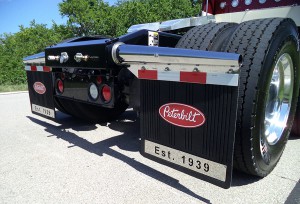 Always at the forefront of both form and function, Peterbilt introduced their first premium aerodynamic truck, the model 387, in 1999. This truck had the company’s first fully-integrated cab and sleeper. In 2005, the model 386 became the first Peterbilt truck to be designated as fuel efficient and environmentally friendly by the EPA’s SmartWay program. In 2010, the PACCAR MX engine made its North American debut and brought exceptional reliability and performance to the Peterbilt line. The introduction of the model 587 in 2011 brought new standards of aerodynamic and operational efficiency to the industry. Which brings us to the present day, and the introduction of the model 579, like Ryan’s.
Always at the forefront of both form and function, Peterbilt introduced their first premium aerodynamic truck, the model 387, in 1999. This truck had the company’s first fully-integrated cab and sleeper. In 2005, the model 386 became the first Peterbilt truck to be designated as fuel efficient and environmentally friendly by the EPA’s SmartWay program. In 2010, the PACCAR MX engine made its North American debut and brought exceptional reliability and performance to the Peterbilt line. The introduction of the model 587 in 2011 brought new standards of aerodynamic and operational efficiency to the industry. Which brings us to the present day, and the introduction of the model 579, like Ryan’s.
Reliving all of this neat trucking history, it is easy to see why Peterbilt trucks are the gold standard of big rigs. If you are a fan of the Peterbilt brand, or just appreciate cool trucks, you will want to come out to Stockton, California on October 24-25 where a special Peterbilt-only truck show is taking place to help celebrate the brand and its milestones. Held at the San Joaquin County Fairgrounds between I-5 and Highway 99, this show is sure to be the event of the year. We at 10-4 Magazine will be there, and flanking our booth will be this 75th Anniversary model 579 on one side and the very last Peterbilt model 379 (Legacy #1,000) ever produced on the other. It’s going to be awesome! For more details, visit www.75thanniversary.org or call Rick McClerkin at (408) 268-3870. We hope to see you there!
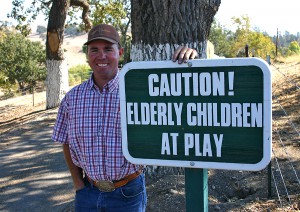 Obviously, not everyone has embraced these aerodynamic trucks, but when you crunch the numbers, it’s hard to ignore how much money you could save by owning one. Ryan Hooten is a tried and true Pete 379 guy, but he bit the bullet and made a change – and so far, he is happy with that decision. And if you can make an aero truck look as good as this one, why not consider one. Maybe it’s time to start changing things up a bit and thinking a little differently – it might be the difference between survival and success. And, whether you like it or not, change is good!
Obviously, not everyone has embraced these aerodynamic trucks, but when you crunch the numbers, it’s hard to ignore how much money you could save by owning one. Ryan Hooten is a tried and true Pete 379 guy, but he bit the bullet and made a change – and so far, he is happy with that decision. And if you can make an aero truck look as good as this one, why not consider one. Maybe it’s time to start changing things up a bit and thinking a little differently – it might be the difference between survival and success. And, whether you like it or not, change is good!
